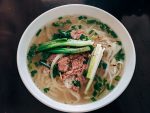Hanoi, the birthplace of phở, is steeped in traditions that have kept the dish authentic and uniquely northern. Unlike its southern counterpart, phở Hà Nội reflects the culinary ethos of northern Vietnam: simplicity, balance, and respect for the ingredients. Let’s explore some of the specific traditions surrounding phở in Hanoi.
Key Features of Traditional Phở Hà Nội
- Broth: The Soul of the Dish
- The hallmark of phở Hà Nội is its clear, aromatic, and savory broth. Made by simmering beef bones (often marrow or knuckle) with onions, ginger, and a medley of spices (star anise, cinnamon, cloves, and coriander seeds), the broth is light yet flavorful.
- Unlike the sweeter southern phở, the Hanoi version prioritizes a clean and subtle flavor, with minimal use of sugar.
- Broth preparation is often an all-night process, with vendors starting the simmering in the early evening to have the soup ready by dawn.
- Beef: The Protein of Choice
- Traditional phở Hà Nội uses various cuts of beef, such as brisket (nạm), flank (gầu), and raw thinly sliced sirloin (tái). These are either cooked in the broth or served raw to cook in the hot soup.
- Chicken phở (phở gà) also has a place in Hanoi traditions, but beef remains the more iconic choice.
- Noodles: Fresh and Soft
- The rice noodles (bánh phở) are thin, flat, and fresh. Vendors in Hanoi often source their noodles locally from specialized suppliers who prioritize quality.
- The noodles are briefly blanched in boiling water to ensure they are soft yet firm, never mushy.
- Minimal Garnishes
- Unlike southern phở, which includes bean sprouts, Thai basil, and hoisin or sriracha sauces, Hanoi-style phở keeps it simple.
- Common garnishes include thinly sliced green onions (hành lá), cilantro (ngò gai), and a lime wedge. Fresh chili slices may be added for those who enjoy spice, but this is optional.
- The restrained use of herbs and condiments ensures that the flavors of the broth and beef take center stage.
The Ritual of Eating Phở in Hanoi
- Early Morning Tradition
- In Hanoi, phở is considered a quintessential breakfast food. Vendors often set up shop before dawn, with locals flocking to their favorite phở stalls in the early morning hours.
- Many of Hanoi’s most famous phở shops, such as Phở Thìn on Lò Đúc Street, are busiest between 6:00 AM and 9:00 AM.
- Communal Atmosphere
- Eating phở in Hanoi is often a social experience. Vendors typically serve the dish in modest settings with communal seating, fostering a sense of community among diners.
- Regulars often have their own “style” of ordering, specifying their preferred cuts of beef or the exact amount of lime and chili.
- “Slurping with Purpose”
- Proper phở etiquette in Hanoi encourages slurping. This is not only a sign of appreciation but also helps aerate the broth, enhancing its aroma and flavor.
Legendary Phở Spots in Hanoi
- Phở Thìn (Lò Đúc Street)
- Famous for its rich and fatty broth, Phở Thìn uses a unique method of sautéing the beef before adding it to the soup, giving the broth an extra depth of flavor.
- Phở Bát Đàn
- This no-frills, queue-up-yourself eatery is renowned for its authentic northern-style phở. It maintains the tradition of letting the broth shine with minimal garnishes.
- Phở Lý Quốc Sư
- A slightly more modernized establishment, this chain is well-loved for maintaining traditional Hanoi flavors while offering a cleaner, more upscale dining experience.
Hanoi’s Seasonal Phở Culture
- Winter Comfort: In Hanoi, phở holds a special place during the colder months. The steaming bowls of soup are especially comforting on foggy winter mornings, and the warm spices take on a heightened significance.
- Summer Adaptation: Even during Hanoi’s hot summers, phở remains popular. Vendors often serve smaller portions or provide additional lime and chili to refresh the palate.
Preservation of Tradition
- Handed-Down Recipes
- Many phở vendors in Hanoi are family-run businesses, with recipes passed down through generations. This continuity ensures that the dish retains its authenticity.
- Vendors take pride in maintaining the delicate balance of the broth, often guarding their spice blends as family secrets.
- Local Ingredients
- Hanoi phở traditions emphasize the use of locally sourced beef, bones, and noodles, supporting regional producers and ensuring freshness.
- Resilience Through Change
- Despite modernization and global influences, Hanoi-style phở has stayed true to its roots. While some shops may experiment with new ingredients, most maintain the classic, minimalist style.
Phở and Hanoi’s Cultural Identity
For Hanoians, phở is more than just food; it is a symbol of the city’s heritage. It encapsulates the city’s ability to adapt to outside influences while preserving its core identity. The restrained, balanced flavors of phở Hà Nội reflect the understated elegance of Hanoi itself, making it a timeless representation of Vietnamese cuisine.

Leave a Reply